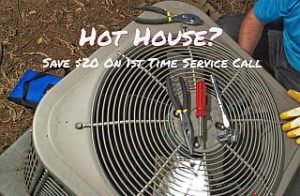Step 1: Conduct Seasonal Checks
As the growing season goes on, shrubs, trees branches, and the like can start to encroach on your AC system outdoor unit. That can affect the efficiency of the condenser. Clear debris from around the unit and keep vegetation at least 2 feet away. Gently rinse away dirt and grass clippings from the outside cover. It’s also important to clean indoor grills and filters on a monthly basis.
Step 2: Turn Up the Temperature
Raising the thermostat setting a single degree could shave 3 to 5 percent from your cooling costs. If your home doesn’t have a programmable comfort control, consider making the upgrade. By automatically adjusting temperatures when you’re away from home, the device can pay for itself in a few short years.
Step 3: Call the Pros at AirVantage
Once a year, have a licensed professional perform a full inspection on your air conditioning units. This will involve cleaning and flushing the condenser coils, flushing the pan and drainage system, checking the blower components, and checking the refrigerant and mechanical parts.
It’s also worth asking them to check the duct system, especially if your cooling bills have been higher than normal. Up to 30 to 40 percent of energy can escape through leaky ducts. If your home also has forced-air heat that uses the same duct system, sealing leaks and adding insulation could end up paying for itself in just a few years.
Is it time for Upgrade?
Today’s central AC system is much more efficient than it was just 10 years ago. Updating or even replacing a system that’s older than that is another way to curb cooling costs, especially if you choose an Energy Star qualified model. Be sure to ask our professional AC service technician about the American Standard Platinum package to learn more about the least failure-prone central AC system.




